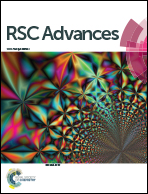Novel wide band gap polymers based on dithienobenzoxadiazole for polymer solar cells with high open circuit voltages over 1 V
Abstract
A new monomer dithieno-[3′,2′:3,4;2′′,3′′:5,6]benzo[1,2-c]xadiazole (fDTBO) is first used as an electron-deficient acceptor to build D–A copolymers in a photovoltaic field. Two polymers PBDTT-fDTBO and PBDTO-fDTBO consist of fDTBO with thienyl-substituted-benzodithiophene (BDTT) or alkoxy-substituted benzodithiophene (BDTO). Both polymers show a deep HOMO around −5.5 eV with a wide band gap of over 1.9 eV. The polymer solar cells (PSCs) based on two polymers both show over 1 V high open circuit voltage (Voc) independent of polymer/PCBM ratios and solvent additives content in the PSCs active layer. The power conversion efficiency (PCE) based on PBDTT-fDTBO devices is 4.5% for single junction PSCs, and these polymers can be applied in tandem PSCs due to their wide band gap (up to 1.99 eV). This work demonstrates that the fDTBO unit is a promising building block to design wide band gap photovoltaic polymers with high Voc.


 Please wait while we load your content...
Please wait while we load your content...